Digital CommunicationDigital communication is made from two words digital and communication. Digital refers to the discrete time-varying signal. Communication refers to the exchange of information between two or more sources. Digital refers to the discrete time-varying signal. Communication refers to the exchange of information between two or more sources. Digital communication refers to the exchange of digital information between the sender and receiver using different devices and methods. The data transmission using analog methods for long-distance communication suffers from distortion, delays, interferences, and other losses. To overcome these problems, the digitization and sampling of signals using different techniques help in making the transmission process more efficient, clear, and accurate. Digital communication is a popular technology used today in electronics. It allows us to access video conferencing, digital meetings, online education, etc. The data can travel upto long distances within a second with the help of the internet and other modes of digital communication. It not only saves money but also saves time and effort. It has also raised the standard of an individual's social, political, and economic life. Here, we will discuss the following: What is Communication? Signals Digital signal History Digital Communication System Advantages of Digital Communication Applications of Digital Communication Digital vs. Analog Data communication vs. digital communication What is Communication?Communication refers to the exchange of information using a specific medium, such as vacuum, space, wireless medium, wired medium, etc. Good communication always transmits information with reduced attenuation and noise. The received signal is the same as the transmitted signal with clear information. Communication is a two-way process of sharing information. In digital terms, communication refers to the exchange of digital information from the transmitter to the receiver. The components of a communication system are the transmitter, communication channel, and receiver. The transmitter transmits the data to the communication channel, which further sends it to the receiver. Various devices are used in cascade or parallel with the transmitters and receivers for different purposes, such as modulation, demodulation, noise removal, sampling, etc. The devices include modulators, filters, amplifiers, encoders, and decoders. SignalsA signal is an electromagnetic wave that carries information from one place to another, using a specific propagation medium, such as air, vacuum, water, and solid. In electronics, the signal is defined as a current, voltage, or wave carrying information. It can travel short distances or long distances depending on the requirements. The speed of a signal wave is equal to the speed of light. The signals are categorized as analog signal and digital signals. 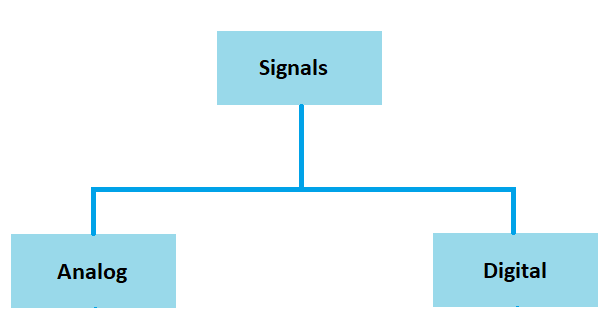
Analog refers to the data transmission in continuous form, while digital refers to the data transmission in the discrete form. It is also known as the transmission in the form of bits, 0 (LOW) and 1 (HIGH). The waveforms of the analog and digital signal are shown below: 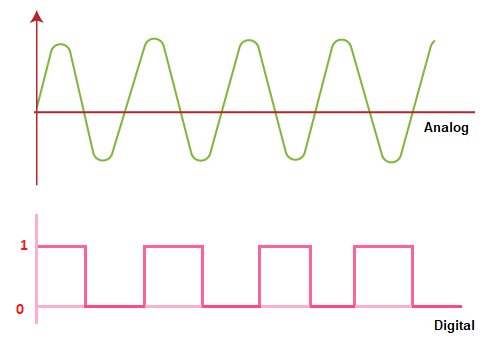
The noise in analog signals is high as compared to digital signal. It is due to the thresholding and high bandwidth of the digital signals. Hence, electronic noise affects analog signals more than digital signals. Filters are generally used in analog communication at transmitting and receiving ends to remove the noise. Digital SignalWe can represent various physical quantities using digital signals, such as voltage and current. A signal represented in the form of discrete values is known as digital signal. It is transmitted in the form of bits. Only two bits (0 and 1) work in different combinations. A digital signal can take only one value at a time from the set of finite possible values. Digital signal is nothing but the representation of the analog data in the discrete form. For example, 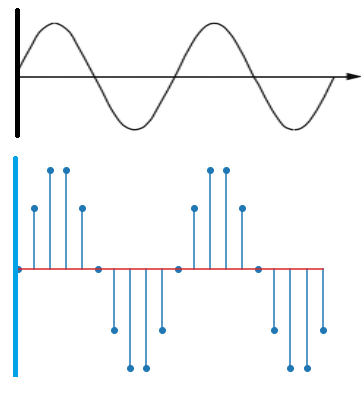
The above two waveforms are the analog and digital waveforms. The digital waveform depicts the information in discrete bands of analog levels. The binary signal is also known as the logic signal because both represent two bands, HIGH and LOW. 0 and 1 are also represented as the numbers in Boolean domain. HIGH = 1 = TRUE LOW = 0 = FALSE A digital system represents a continuous waveform switching between the discrete values called bitstreams in a communication system. It allows cost savings with reduced transmission time. The noise interference during the transmission can be effectively removed using the data redundancy process or data compression, where the data is encoded using fewer bits than the original information. Types of Digital SignalA signal that repeats over a period of time is termed a periodic signal. A signal that does not repeat over a period of time is termed as an aperiodic signal. Digital signals and analog signals are categorized as periodic and non-periodic signals. Here, we will discuss the types of the digital signal in detail. 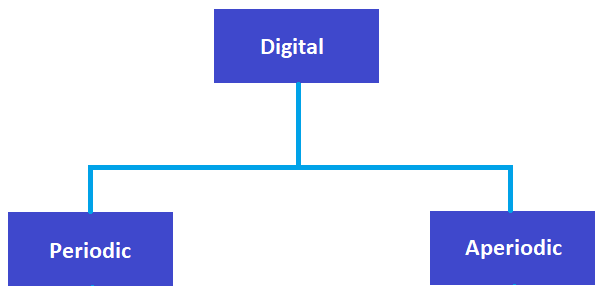
Periodic signals A digital signal that repeats over a period of time is known as periodic signals, such as square wave. 
Aperiodic signals A digital signal that does not repeat over a period of time is known as an aperiodic signal. It is also a discrete signal, but not of repeated pattern. For example, 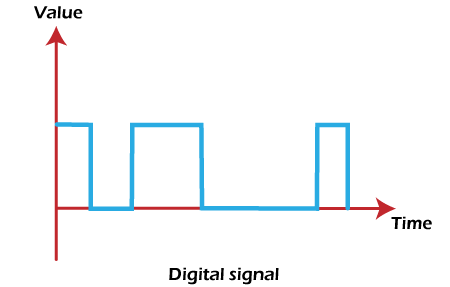
History
Digital Communication SystemA digital communication system refers to data transmission from one place to another. It is the communication between the sender and receiver. A sender is also known as transmitter that transmits the data. A communication channel between the transmitter and receiver acts as intermediate source to carry the information to the receiver. The block diagram of a digital communication system is shown below: 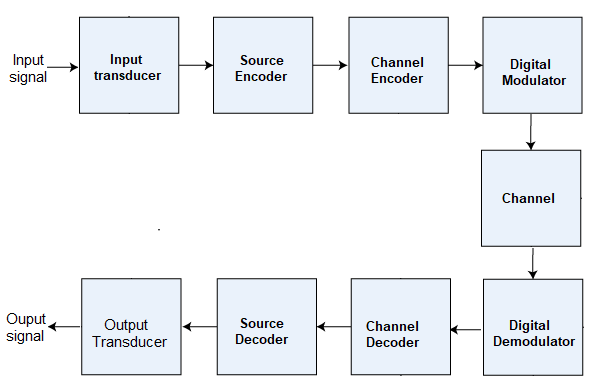
It consists of an input transducer, source encoder, channel encoder, digital modulator, communication channel, digital demodulator, channel decoder, source decoder, and output transducer connected in series. Let's discuss the function of each component in the digital communication system. Source signalThe source signal refers to the input signal applied to the digital communication system. It is also known as the input signal. Digital communication is generally used as a conversion system from analog to digital. Thus, the input signal is generally an analog signal. It can be analog or digital. In case of the analog signal as the input source signal, the digital communication system also works as an analog to digital converter by converting the analog input to the digital output. Input TransducerThe transducer is a device used to convert one form of energy to another. In a communication system, it converts the non-electrical energy to electrical energy to make it suitable for transmission within the system. In the case of the analog input, the block also contains an ADC (Analog to digital converter) to convert analog to the digital signal for further processing. Source EncoderThe source encoder compresses the data to the reduced number of bits from the original bits. It helps in effective bandwidth utilization and also removes unnecessary bits. It means that the compressed data is in the form of binary digits. We can also say that the source encoder converts the waveforms to binary data. The output data is further passed to the channel encoder. Channel EncoderThe information in the signal may get altered due to the noise during the transmissions. The channel encoder works as an error correction method. It adds redundant bits to the binary data that helps in correcting the error bits. It enhances the transmission quality of the signal and the channel. Digital ModulatorA carrier signal modulates the received signal. It modulates the digital by varying the transmitted signal's frequency, amplitude, and phase. Communication channelThe communication channel is the medium between the transmitter and the receiver. It helps in transmitting a digital signal from the transmitter to the receiver. The data rate of the channel is measured in bits per second. The various types of channels in a digital communication system are email, project management apps, and Intranet. Digital DemodulatorThe signal is demodulated and the source signal is recovered from the carrier signal. Channel decoderThe function of the channel encoder is to add the redundant bits to the binary data, as discussed above. The channel decoder works in the same but opposite way. It removes the parity bits from the binary data. It does not affect the signal quality and the information and transmits the data securely. The output of the channel decoder is a pure digital signal with no interference or noise. Source decoderThe source encoder works oppositely as that of the source encoder. It converts the binary data back to the waveforms. Output TransducerThe output transducer works in the opposite was as that of the input transducer. It converts the electrical energy back into its original form. It makes the information suitable for the user at the output to capture. The conversion is essential at both the ends of the communication system to make the system operate at a faster rate. Output signalThe output signal refers to the output from the digital communication system. It is the signal that appears at the output after passing through various communication system components. The output signal is only a digital signal. Noise removal componentsNoise in the system can cause information loss and distortion. Hence, it is essential to use the noise removal components in the communication system. The noise removal components are used at both the transmitting and receiving ends to filter out the noise components from the signal. The noise components include anti-aliasing filters, shielded cables, and grounding concepts. The grounding acts as a reference voltage for the circuit and helps in preventing coupling. Function of the digital communication systemWe have already discussed about each component in detail. Let's discuss how the data from one end through the transducer is transmitted to the receiving end. It makes the data available to the receiver without any noise or distortion. Here, we will discuss an example of the video signal. The videos signal is first applied to the input transducer that converts the signal into the electrical form. The source encoder compresses the data to the reduced number of bits and the channel encoder removes the error by adding the redundant bits to the input digital data. It helps in encoding the signal into binary digit or seven digits PCM (Pulse Code Modulation). These are also used to represent the original video signal. The modulator modulates the signal by varying the amplitude, frequency, or phase of the transmitted signal. The transmitted signal passes through the communication channel to reach the receiver. At the receiving end, the demodulator helps in recovering the message signal from the carrier. The channel decoder, source decoder, and the output transducer convert the digital signal into its original form of transmission. The output signal is a digital signal with no interference, noise, and error and is suitable for the user to capture. Advantages of Digital CommunicationThe advantages of digital communication are as follows:
Disadvantages of Digital CommunicationThe disadvantages of digital communication are as follows:
Applications of Digital CommunicationThere are various applications of digital communication ranging from small digital clocks to large industrial instruments. Let's discuss some of the most common applications of digital communication.
Digital vs. AnalogThe digital computers were the first technologies used to store the digital record with a large size occupying the space of a room. The later inventions created new history and today digital computers are used to store millions of data with a size similar to rice grain. The differences between digital communication and analog communication are listed in the below table:
Data communication vs. digital communicationThe terms data communication and digital communication sometimes creates confusion. The concept of both the terms is quite same, but the components and working is different. Let's discuss the differences between data communication and digital communication.
PrerequisiteThe requirement to learn Digital Communication is the basic knowledge of communication concepts. A basic understanding of Signal and Systems, Electronics and Communication would be an advantage. AudienceThe Digital Communication tutorial is intended for beginners, students who want to acquire knowledge of digital communication. The basic knowledge of digital transmission concepts is required before beginning with the Tutorial, which is discussed above. ProblemWe assure you that will not find any problem with this Digital Communication Tutorial. But if there is any mistake, please post the problem in the contact form.
Next TopicPCM (Pulse Code Modulation)
|
 For Videos Join Our Youtube Channel: Join Now
For Videos Join Our Youtube Channel: Join Now
Feedback
- Send your Feedback to [email protected]
Help Others, Please Share










